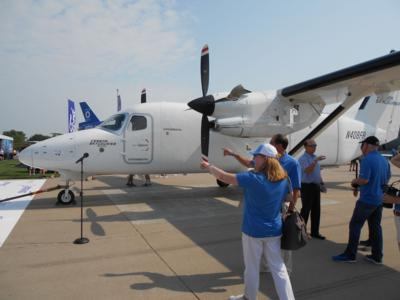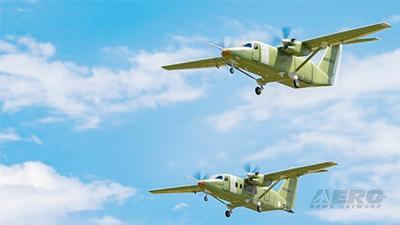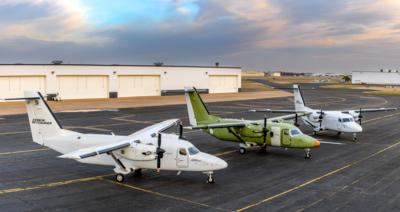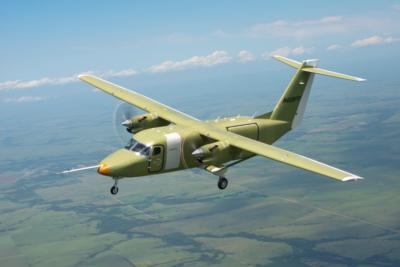There Is Also A 19 Seat Passenger Version In The Works
It slices! It dices! It can host a huge tailgating party! And it will give FedEx a sorely needed feeder aircraft that can haul a whopping three tons of cargo.

Sporting the largest cargo door in its class of aircraft, Cessna showed off its new twin-turboprop Sky Courier 408 cargo bird specifically designed to be FedEx Express' new feeder bird, for which FedEx entered into a purchase agreement with Te. If you thought it would be just another Caravan on steroids, think again. It is a clean sheet design and it is impressive. The cargo deck can accomodate three standard LD3 containers. This type of container is available in normal and refrigerated configurations
The aircraft is designed to be operated in high frequency operations, fully loaded, with a relatively low operating cost. It has a rugged landing gear that will allow it to operate from fields that are currently unreachable with the types of cargo that the Sky Courier can carry. It also has single-point refueling under the starboard engine for quick turnaround, although the refueling point would require the refueling operator to place the hose and hardware very close to the deicing boot slightly aft of the engine.

Although the test flight vehicle shown at Oshkosh has a pure cargo configuration, there is also a 19 seat passenger version in the works, as well as a combi version with passenger seats and a cargo area. Already quite a few operators have expressed an interest in the aircraft for both civilian and military mission profiles. The Sky Courier may very well be headed for as successful a run as the Caravan series.
Interestingly, the aircraft will also be used in FedEx's Purple Runway program, which aims to train pilots and guide them through the path from the feeder seats to mainline positions in the fleet.
The aircraft is also equipped with features that make the ground crews' job easier and safer, such as an external bus connector which, when powered, provides key lighting for cargo and maintenance operations. The cargo door itself, while very large, can be operated by one person assisted by gas struts. Any sensitive items installed outside the aircraft such as pitot tubes and other sensors are not easily reached from the ground without a ladder, except for one AOA vane on the pilot side of the front fuselage.

The cockpit is too high to be reachable from the ground, but an easy-to-operate and -stow ladder system makes it possible for the crew to safely board and deplane. The aircraft is also intended to be certified for single-pilot operation thanks to advance cockpit automation. An interesting feature is a mechanical gust lock operated from inside the cockpit which extends some eighteen inches back from the throttle quadrant and allows for the aircraft to be towed without restriction. The lock immobilizes all flight control surfaces on the wings and empennage.
To prevent an attempt to so much as taxi with the gust lock engaged, the throttles are physically locked and cannot be operated when the gust lock is engaged. When queried about the robustness of this system, a Cessna test pilot stated it would be impossible to move the throttles when the gust lock is engaged. Another safety feature of the cockpit is a laminated glass windshield, which the media was told will not be tested with frozen chickens.
The only operating performance numbers available at press time were the takeoff distance of 3,300 ft. of runway with the aircraft fully loaded, 200 knots cruise airspeed and 900 nm range. Certification flight testing continues, and further specifications will be released when available.



 Senator Pushes FAA to Accelerate Rocket Launch Licensing
Senator Pushes FAA to Accelerate Rocket Launch Licensing Classic Aero-TV: RJ Gritter - Part of Aviations Bright New Future
Classic Aero-TV: RJ Gritter - Part of Aviations Bright New Future Aero-FAQ: Dave Juwel's Aviation Marketing Stories -- ITBOA BNITBOB
Aero-FAQ: Dave Juwel's Aviation Marketing Stories -- ITBOA BNITBOB ANN's Daily Aero-Linx (10.27.24)
ANN's Daily Aero-Linx (10.27.24) ANN's Daily Aero-Term (10.27.24): Clearance Void If Not Off By (Time)
ANN's Daily Aero-Term (10.27.24): Clearance Void If Not Off By (Time)








